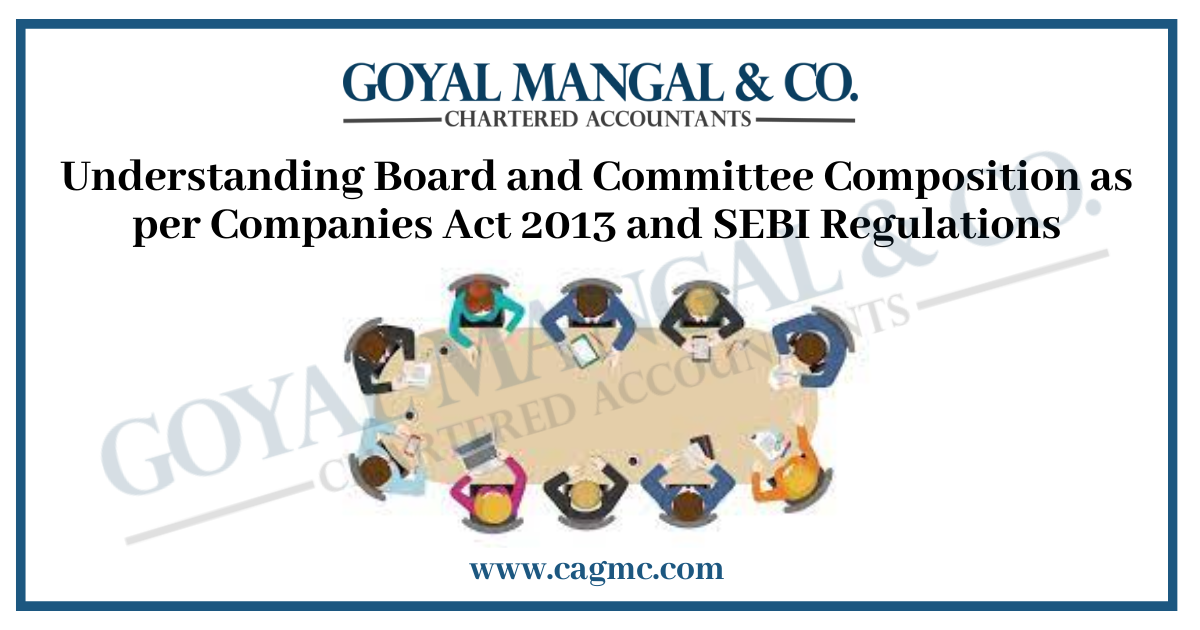
A company’s governance and decision-making are heavily influenced by the board and committees’ composition. The SEBI (Securities and Exchange Board of India) regulations and the Companies Act of 2013 provide out detailed rules and standards for the composition of boards and committees at listed Indian businesses. This blog will break down these complex rules and regulations and examine how they affect corporate governance to promote openness and responsibility in business.
Table of Content
Meaning of Board & Committee Composition
Board and audit committee composition pertains to the organizational framework and constituent elements of a company’s board of directors and diverse committees that aid in its governance and legislative procedures. This includes the identification of the appropriate number of directors, their necessary credentials, description of their respective duties and responsibilities, and the formation of dedicated committees, such as audit committees, nomination and pay committees, and risk management committees.
Board Composition as per Companies Act 2013
At least one third of its board of directors of every public traded company must comprised of “independent” members. The below mentioned companies must have a minimum of two independent directors in Board Composition as per Companies Act :
- Public Companies with a paid-up share capital of 10 crore rupees or higher
- Public Companies with a turnover of 100 crore rupees or higher
- Public Companies with a combined total of outstanding deposits, loans, and debentures exceeding 50 crore rupees.
Board Composition as per SEBI LODR Regulation, 2015
For the listed entities Board composition should be as follows:
- At least one female director should be included in an ideal board composition that includes both executive and non-executive positions.
- There should be minimum half of the board that isn’t an executive.
- A non-executive director must serves as chairman of the board and the independent director should be at least one third of the board.
- If the chairman is an executive director, the number of independent directors must be at least half of the executive directors.
- If the company’s regular Non-Executive Chairperson is linked to the promoter or managers at the board level or below, a publicly traded company’s Board must include at least half independent directors.
- Sixth, if a publicly traded company has extraordinary SR equity shares, at least half of the board members must be considered “Independent Directors.”
- The approval of the shareholders is required to add a new board of member.
- Three months following the date of appointment, or at the next general meeting, this approval is needed.
- After April 1, 2024, directors of publicly traded companies must receive shareholder approval at an annual or special company meeting under Companies Act, 2013 conducted every five years to continue remaining on the board.
- If a directorship becomes vacant at a publicly traded company, the board must fill it within three months.
Composition of Audit Committee as per Companies Act 2013
Companies with 10 crore rupees or more paid-up share capital; 100 crore rupee or more turnover; and having loans, debentures, and deposits over 50 crore rupees. The Board of Directors must establish an Audit Committee for such companies
At least three Independent Directors, will serve on the Audit Committee. The Audit Committee’s chairperson and members should be financially literate.
Composition of Audit Committee as per SEBI LODR Regulation,2015
- All publicly listed companies must have an independent audit committee that is mandatory committee for the listed company. At least three directors must be on the audit committee.
- Two-thirds of the members of the audit committee must consist of Independent Directors.
- If a publicly traded company possesses unredeemed SR equity shares, the composition of the audit committee must consist solely of Independent Directors.
- Every audit committee member must understand finances, and at least one must be an expert in accounting or financial field.
- The audit committee chair must be an independent director.
Composition of Nomination & Remuneration Committee as per Companies Act, 2013
The Board of Directors of:
- Every listed company
- There are three criteria that determine the classification of public companies.
- Firstly, public companies with a paid-up share capital of 10 crore rupees or more. Secondly, public companies with a turnover of 100 crore rupees or more.
- Lastly, public companies that have a combined total of outstanding loans, debentures, and deposits overtaking 50 crore rupees.
- A Nomination and Compensation Committee has to be formed.
- At least three Non-Executive Directors must be on the Nomination and Remuneration Committee, with at least half being Independent.
- The Chairperson of the Company can serve on the Nomination and Remuneration Committee, regardless of their executive or non-executive function.
- The Chairperson cannot serve as Committee chair without Committee consent.
Composition of Nomination & Remuneration Committee as per SEBI LODR Regulation, 2015
- Every publicly traded company must have a Nomination and Remuneration Committee.
- The committee must have three Directors.
- The committee’s board will only include Non-Executive Directors.
- According to the rules, at least two-thirds of directors must be independent.
- An Independent Director serves as Chairperson for the nomination and remuneration committee, according current protocols.
- Listed Company Chairpersons, whether executive or non-executive, are acceptable Nomination and Remuneration Committee members.
- Please note that they do not meet the eligibility criteria for the committee chair position.
Composition of Stakeholder Relationship Committee as per Companies Act, 2013
Any corporation with more than 1,000 shareholders, debenture holders, deposit holders, and other securities will have a Stakeholders Relationship Committee constituted by the Board of Directors throughout its fiscal year. The Board of Directors will decide how many extra members are needed, and a non-executive director will head it.
Composition of Stakeholder Relationship Committee as per SEBI LODR Regulation, 2015
It is a requirement for every listed company to establish a Stakeholder Relationship Committee. The individual appointed as the Chairperson of the Stakeholder Relationship Committee will occupy the position of a Non-Executive Director. The composition of the Committee shall have a minimum of three Directors, including at least one Independent Director. If a Listed Entity possesses outstanding SR Equity Shares, it is required that a minimum of two-thirds of the Stakeholders Relationship Committee be composed of Independent Directors.
Composition of Risk Management Committee as per SEBI LODR Regulation, 2015
The board of directors creates the Risk Management Committee. The Risk Management Committee needs three members, most of whom should be Board of Directors.
The committee must also include at least one person who serves as an Independent Director.
There must be at least two-thirds Independent Directors on the Risk Management Committee if the company is publicly traded and has outstanding shares of SR stock. Having a seat on the Board of Directors is a prerequisite for chairing the Risk Management Committee. Senior Executives from the listed company may also be invited to join the committee.
Takeaway
It is essential for good corporate governance that the Board and its committees remain properly constituted. Companies Act of 2013 and the SEBI (LODR) Regulations of 2015 establish regulations that must be followed by listed firms and those that meet certain financial conditions. Businesses can benefit from a more open and effective decision-making process that serves the interests of their shareholders and other stakeholders if they follow the rules.


